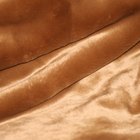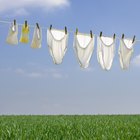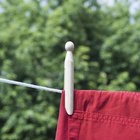
Wool and other animal-based fabric materials are susceptible to the larvae of moths. Soiled and improperly stored wool objects are particularly likely to become infested with moths and their larvae. Moth larvae feed on wool and generally damage unnoticeable areas of garments, such as under shirt cuffs and collars. Aside from actual damage, these shiny, white larvae spin protective webbing as they feed, forming silky cocoons in wool. Promptly kill moths and their larvae in wool to protect garments from damage.
Take the wool item outdoors to expose the moth larvae to sunlight. Brush the wool with a fabric brush to detach moth eggs, larvae and cocoons. The brushing action destroys moth eggs and exposes the larvae to sunlight, which causes larvae to fall off wool.
Place the wool garment in a polyethylene bag and squeeze out excess air. Tightly seal the bag and freeze the encased wool at or below 0 degrees Fahrenheit. Keep the wool item in the freezer for at least 72 hours to thoroughly kill the remaining moth larvae.
Examine the wool for lingering moth larvae. If cocoons or small, white caterpillars remain in the wool, take the garment to a dry cleaners to have the wool professionally dry cleaned. Dry cleaning is the only complete option for cleaning moth-infested wool garments and killing all stages of moths.
Store the clean, moth-free wool item in an airtight container with a moth control product containing naphthalene or paradichlorobenzene to prevent future moth infestation. Place the moth control product between several layers of paper to ensure the product doesn’t damage the wool item.
Related Articles

How to Clean Viscose Shawls

How to Prevent Fabric Dry Rot

How to Keep a Fleece-Lined Jacket From ...

Care of Mohair Fabric

Proper Care & Washing of Nylon Panties

What Types of Insects Eat Leather?

How to Not Get Holes in silk cashmere ...

How to Repair a Mink Coat That Is ...

How to Get Sticker Residue Off of Suede ...

How to Get Rid of Bugs That Eat Holes ...
How Long Can Flour Be Stored in Mylar ...

How to Whiten Jeans

How to Fix Cuts in Polyester Clothes

How to Dye Faded Black Dress Pants

Why Do White Clothes Turn Yellow in ...

How to Protect Cashmere Scarves From ...

How to Wash a Rubber Raincoat

How to Store Clothes in Storage

How to Get Wrinkles Out of Nylon ...

Removing White Fuzzy Mold From Dark ...
References
Writer Bio
April Dowling first started writing in high school and has written many news articles for newspaper and yearbook publications. She is currently pursuing a career as an online writer and affiliate marketer. Dowling writes for several websites and keeps many blogs.
Photo Credits
Hemera Technologies/AbleStock.com/Getty Images